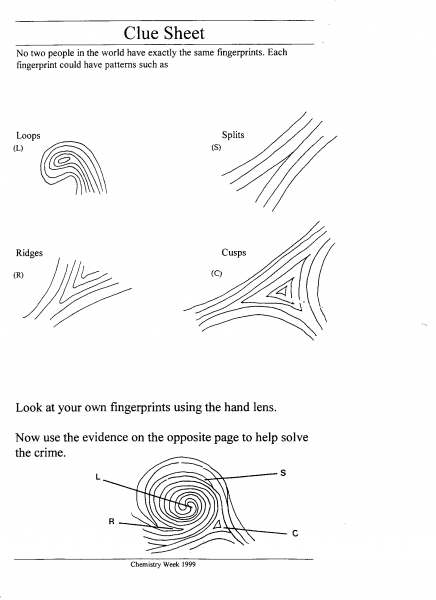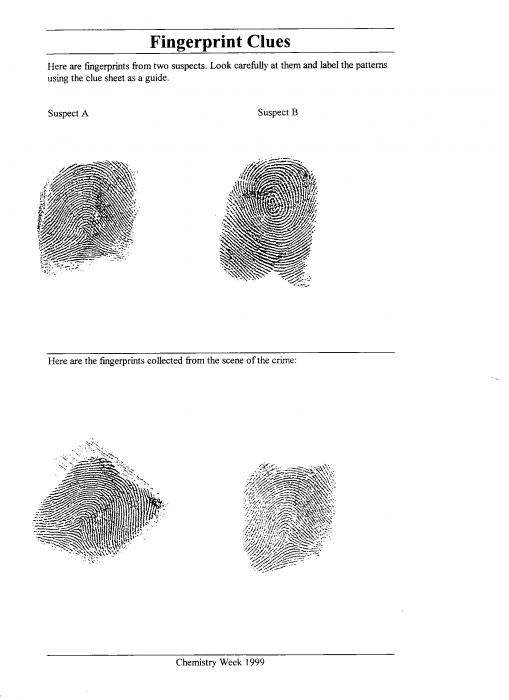Forensic Science Investigation/Lesson
This resource comes from a large collection of paper-based PGCE Science teaching materials at FoE
Introduction
This series of activities has been used both as lesson material and as a circus of activity. It might have been used for example for a school open day and had students wear safety specs and laboratory coats.
The teacher has brought together some common school lab activities and given them an investigative slant in a ‘real world’ context.
- A context to introduce the science topic ’acids and bases’ to lower secondary school students by measuring the pH of soil found on a crime suspect’s shoe.
- A context to introduce the technique of chromatography, by comparing the ink from a pen at the crime scene, with ink owned by a suspect. This activity is often used in work to distinguish between mixtures and compounds
- A context, to introduce human variation by comparing suspect’s thumb prints with that found at the crime scene. Fingerprinting is sometimes used as a starter activity to naturally lead to discussing what we inherit from our parents.
- Unless we’ve missed a trick, a final activity appears to have no connection to the story. In this activity, pupils measure the acidity of household liquids. Again this activity is to introduce the topic ’acids and bases’.
Forensic Science Investigation
It was a silent night, only interrupted by the sound of breaking glass and a scream erupting from the building. In the morning, the first evidence of the break-in is a broken window – but there’s a body, a pen next to it, and a footprint in the soil outside the window. A large thumbprint is found on a window handle. It is time to call the Forensic Science team!
Name of the forensic scientist: ____________________________________________
Clue Sheet
No two people in the world have exactly the same fingerprints. Each fingerprint could have patterns such as:
Look at your own fingerprints using the hand lens. Now use the evidence on the opposite page to help solve the crime.
Fingerprint Clues
Here are fingerprints from two suspects. Look carefully at them and label the patterns using the clue sheet as a guide.
Clue Sheet
Soils can be acid or alkalis. You can test this out by using an indicator.
1. Put a small amount of soil into a small beaker and add pure water from the plastic bottle.
2. Stir the soil and water well until you have a beaker full of muddy water.
3. Dip a small piece of yellow indicator paper into the muddy water and allow the water to soak up the paper.
4. Match the colour with a colour chart.
Acids turn the paper red, alkalis turn the paper dark blue, neutral soils turn the paper green.
Soil Washing Clues
Samples of soil were collected from a suspect’s shoes and from the footprint outside the broken window. Test these samples and stick your indicator paper on a sheet of divided into three columns (Suspect A, Suspect B and Suspect C). Then write down what you think these clues tell you.
Chromatography to study the ink in the pen
Ink is made up of many coloured dyes. Black ink, for example, often has three or four different dyes. Each brand of ink contains different dyes too. It is possible to separate the dyes by using special paper, like coffee filter paper. What you need to do is:
1. Put a very small spot of the ink sample on the bottom of a strip of special chromatography paper. Label with a pencil.
2. Then dip this paper into a beaker containing a small amount of water. Make sure the ink spot is above the water level.
3. Watch the water rise up the paper carrying the dye particles with it.
4. Be patient and let the water run almost to the top of the paper.
5. You will be able to see the different colours of ink along the strip of paper.
Clues from the pen
You have samples of ink from the pen found at the scene of the crime and ink from cartridges found in the pocket of the two suspects. Test them and see if you can link the suspect to the crime. Stick your strips of paper, called chromatograms on a sheet of paper divided into three columns (Suspect A, Suspect B and Crime Scene). Write down what you think these clues tell you. Can you advise the police on who the murderer might be? Look at the evidence you have collected. Summarise your ideas.
Acids and Alkalis are in your home
Acids turn indicator red. Alkalis are the opposite of acids and turn indicators blue. Find out which kitchen chemicals are acids and which are alkalis. This is what you need to do:
1. First add one drop of green indicator to each well of a white tile.
2. Now add one drop of each test liquid to the correct well. For example, add liquid number one to well number one. Always use a clean pipette for each new liquid.
3. Write down what colour the indicator turns when the liquid is added in a table.
My mum uses vinegar on both wasp stings and bee stings. Is she right? Test the bee stings and wasp stings and suggest what she could use from the kitchen for each sting.


